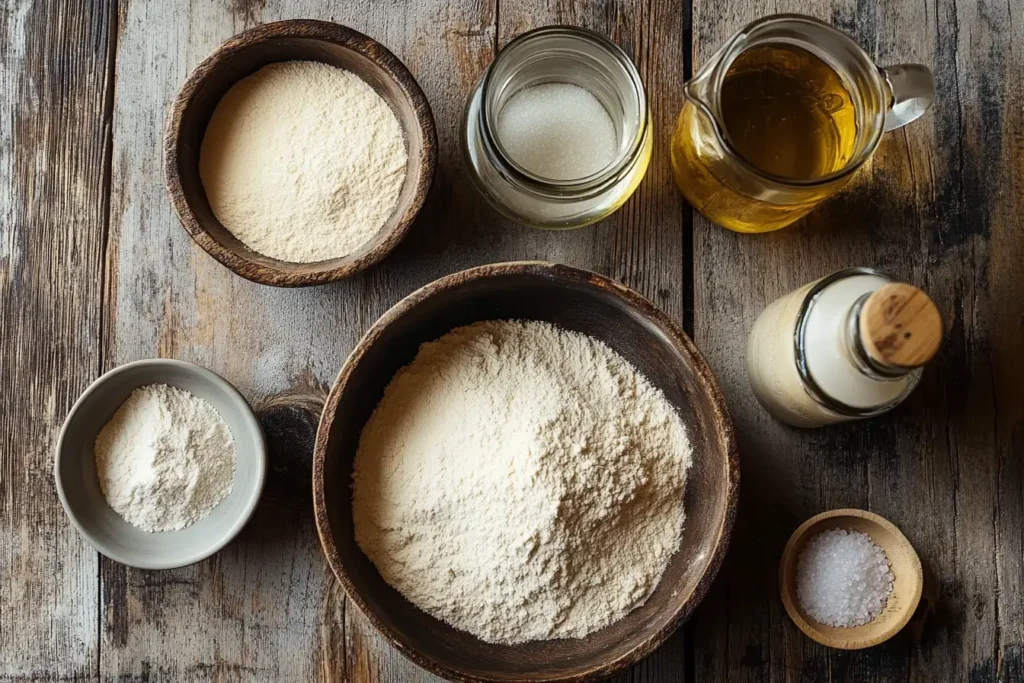Exploring the Treat of Sourdough Bagels
Few foods blend tradition, flavor, and nutrition as effortlessly as sourdough bagels. These chewy, golden rings bring a delightful balance of tangy sourdough notes and classic bagel texture. In this guide, we’ll dive deep into their origins, health perks, and the art of crafting them at home. Whether you’re a seasoned baker or just starting, this article will take you step-by-step through making, enjoying, and even troubleshooting these artisan delights.
What Are Sourdough Bagels?
Sourdough bagels are a unique twist on traditional bagels, combining the bold, tangy flavor of sourdough fermentation with the dense, chewy texture bagels are famous for. Unlike conventional bagels that rely on commercial yeast for leavening, sourdough versions use a natural starter, enhancing flavor and making the bagels easier to digest.
Crafted through slow fermentation, sourdough bagels develop a deep, complex taste that appeals to foodies and health enthusiasts. Moreover, their versatility allows bakers to experiment with artisan bagel toppings like seeds, spices, or even sweet glazes.

History and Origin of Sourdough Bagels
Bagels trace their roots to Eastern Europe, where they became a staple for Jewish communities in Poland. Over time, these boiled-and-baked breads crossed oceans and became a breakfast icon worldwide. On the other hand, sourdough has an ancient lineage, with its roots reaching thousands of years back to early bread-making civilizations.
The fusion of sourdough and bagels likely arose in the artisanal baking renaissance of the late 20th century, as bakers began revisiting traditional methods to craft products with natural flavors and a touch of nostalgia. Today, conventional bagel methods meet sourdough’s robust fermentation science, creating a culinary experience that’s as wholesome as delicious.
For more about sourdough baking techniques, check out my Tips & Techniques.
Health Benefits of Sourdough Bagels
Nutritional Profile of Sourdough Bagels
Sourdough bagels take the prize for a wholesome balance of flavor and nutrition. Unlike their regular counterparts, these bagels benefit from the natural fermentation that enhances nutrient availability. They’re rich in complex carbohydrates, which provide a steady energy source, and they also offer more digestible proteins than conventional bagels.
Additionally, sourdough fermentation breaks down phytic acid, a compound inhibiting mineral absorption. This means that the essential minerals in sourdough bagels—like magnesium, iron, and zinc—are more readily available to your body. And let’s not forget their fiber content! Many recipes use whole-grain flour, promoting digestive health and keeping you full longer.
Digestive Advantages of Sourdough Fermentation
One of the standout perks of sourdough fermentation is its impact on gut health. The natural acids and beneficial bacteria pre-digest the dough, making it gentler on your stomach. It is particularly helpful for individuals with mild gluten sensitivities, as sourdough’s fermentation breaks down some gluten proteins.
The low glycemic index of sourdough bagels is another plus. Thanks to the extended fermentation, the carbohydrates in sourdough are digested more slowly, helping regulate blood sugar levels. Pairing this with nutrient-packed toppings like avocado or smoked salmon takes flavor and nutrition to the next level!
For a deeper dive into the health benefits of sourdough bread and bagels, visit Healthline’s guide.
Making Sourdough Bagels at Home
Essential Ingredients for Sourdough Bagels

Crafting homemade sourdough bagels requires just a handful of ingredients, yet each plays a crucial role in achieving the perfect balance of flavor and texture. Here’s what you’ll need:
- Sourdough starter: The heart of the recipe, providing leavening and flavor.
- Flour: High-gluten flour is ideal for that signature chewy bagel texture.
- Water: To hydrate the dough and activate the starter.
- Salt: Enhances flavour and controls fermentation.
- Sweetener: Honey or malt syrup adds a touch of sweetness and helps with browning.
Step-by-Step Guide to Homemade Sourdough Bagels
Making sourdough bagels is as much about patience as it is about skill. Follow these steps to enjoy bakery-quality bagels right at home.
Preparing the Sourdough Starter
Begin by feeding your sourdough starter a day before baking. A well-fed starter is active and bubbly, ensuring proper fermentation. Combine equal parts flour and water with the existing starter and let it rest at room temperature for 4–8 hours.
Mixing and Kneading the Dough
In a large bowl, mix the active starter with water, flour, salt, and sweetener. Knead the dough until it’s smooth and elastic—this might take about 10–15 minutes. Cover the dough with a damp cloth and let it rest for a few hours until it doubles in size.
Shaping and Proofing the Bagels


Divide the dough into equal portions and roll each into a ball. Poke a hole in the center of each ball and gently stretch it into a bagel shape. Place the shaped dough on a lined baking sheet and proof it overnight in the refrigerator for optimal flavor development.
Boiling and Baking Techniques
The magic of traditional bagel methods lies in boiling. Bring water to a boil and add a tablespoon of baking soda for that signature chewy crust. Boil each bagel for 30–60 seconds per side, then transfer them to a baking sheet. Bake in a preheated oven at 425°F until golden brown, typically 20–25 minutes.
Enhancing Your Sourdough Bagels
Popular Toppings and Flavors
The versatility of sourdough bagels is part of what makes them so beloved. From savory to sweet, the possibilities for toppings are virtually endless. A generous sprinkle of sesame, poppy seeds, or bagel seasoning adds the perfect crunch for those who enjoy the classics.
Feeling adventurous? Try topping your bagels with parmesan and garlic for a savory twist or cinnamon and sugar for a breakfast treat. Even adding dried fruits like cranberries or raisins to the dough can create delightful sweet options. Don’t forget that creative bagel flavors like jalapeño-cheddar or sun-dried tomato basil are also crowd-pleasers.
Creative Serving Suggestions

Sourdough bagels are more than just a breakfast staple; they can easily transform into gourmet meals. Here are some creative ways to serve them:
- Breakfast Bliss: Top your bagel with smashed avocado, poached eggs, and a sprinkle of chili flakes for a nutrient-packed start to your day.
- Lunchtime Favorite: Make a hearty sandwich with smoked salmon, cream cheese, capers, and fresh dill for a satisfying midday meal.
- Spread almond butter, add a drizzle of honey, and finish with banana slices for a healthy, sweet treat. For more ideas, try pairing your breakfast with our Sourdough Cinnamon Raisin Bagels or indulge in rich Sourdough Brownies for dessert.
- Pizza Bagels: Slice bagels in half, spread marinara sauce, add mozzarella cheese and toppings, then bake until bubbly.
These ideas showcase how artisan bagels can elevate any meal from ordinary to extraordinary!
Troubleshooting Common Issues
Addressing Common Sourdough Bagel Challenges
Even seasoned bakers can face hiccups when making sourdough bagels. Understanding common issues and how to fix them ensures your baking journey remains enjoyable and frustration-free.
- Flat Bagels: If your bagels lack height, the dough might have over-proofed, or the starter wasn’t active enough. Ensure your starter is bubbly, and allow the dough to rise until it is doubled.
- Dense Texture: If the bagels are too heavy, it may be due to insufficient kneading. Knead the dough until it’s smooth and elastic to develop gluten, which gives bagels their characteristic chew.
- Sticky Dough: A dough that is too sticky might require additional flour during kneading. However, avoid adding too much, which can dry the bagels.
- Uneven Crust: Boil the bagels evenly on both sides for consistent texture and color. Using baking soda in the boiling water also helps achieve a beautiful, glossy finish.
Troubleshooting Common Issues
Addressing Common Sourdough Bagel Challenges
Perfecting the art of sourdough bagels can feel like a science, and even small missteps can lead to unexpected results. Thankfully, most issues can be easily fixed with a few adjustments. Let’s look at some common challenges and how to overcome them:
- Bagels Are Too Hard: If your bagels come out overly tough, it might be due to over-boiling. Boil the bagels for no more than 60 seconds per side to balance chewiness and softness.
- Lack of Flavor: Insufficient fermentation time often leads to bland bagels. The dough is proven overnight in the refrigerator to develop the tangy, complex sourdough flavor.
- Cracked or Split Bagels: This could occur if the dough isn’t shaped tightly enough or proofed properly. Take extra care when forming your bagels to seal the seams and proof them in a draft-free environment.
- Burnt Bottoms: If the bottoms are scorched, double-line your baking sheet or use a silicone mat. Rotating the tray halfway through baking can also help prevent uneven browning.
With these fixes in mind, you’ll be well on your way to consistently delicious sourdough bagels that look and taste professional!
Frequently Asked Questions
What makes sourdough bagels different from regular bagels?
Sourdough bagels use a natural sourdough starter for leavening, while regular bagels rely on commercial yeast. This results in a tangier flavor, improved digestibility, and a unique chewy texture.
How do I maintain a sourdough starter for bagels?
Maintaining a starter is easy with regular feedings of equal parts flour and water. Store it in the fridge occasionally or at room temperature if you bake frequently. Feed it every 1–2 weeks in the refrigerator or daily when kept out.
Can I add flavors or mix-ins to sourdough bagel dough?
Absolutely! Popular mix-ins include dried fruits, nuts, herbs, and cheese. Be sure to incorporate them during the final stages of kneading for even distribution.
Why is boiling necessary before baking bagels?
Boiling locks in the shape and creates the bagel’s characteristic chewy crust. Adding baking soda or honey to the water enhances the texture and golden color.
How should I store homemade sourdough bagels?
Store them in an airtight container at room temperature for 2–3 days, or freeze them for longer storage. To reheat, slice, and toast or refresh them in a warm oven.
Can I freeze sourdough bagels for later use?
Yes, freezing is a great way to preserve their freshness. Wrap each bagel individually and store it in a freezer-safe bag. Thaw at room temperature and reheat before serving.
Conclusion
Sourdough bagels are a perfect blend of tradition, flavor, and nutrition, offering a delightful experience for both bakers and food enthusiasts. From understanding their origins to mastering the art of making them at home, these chewy, golden treats provide endless opportunities for creativity and enjoyment. Whether crafting classic varieties or experimenting with unique toppings and flavors, sourdough bagels will surely become a cherished addition to your culinary repertoire. Happy baking!

